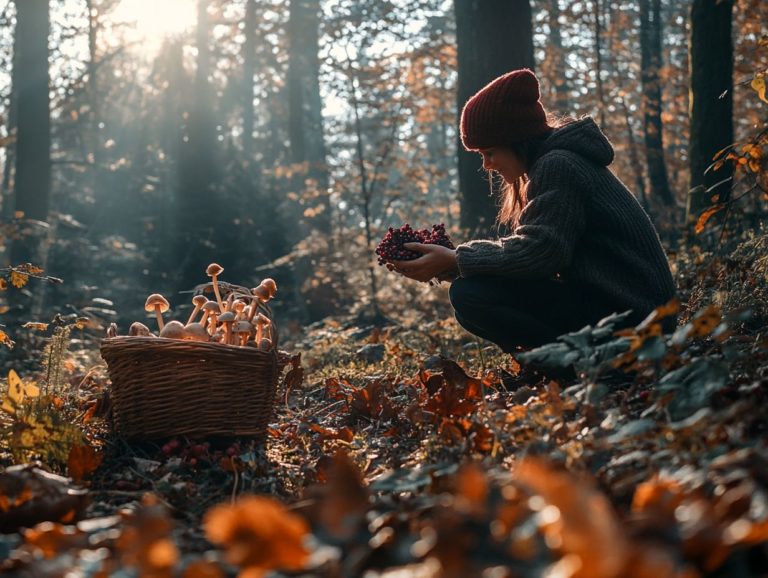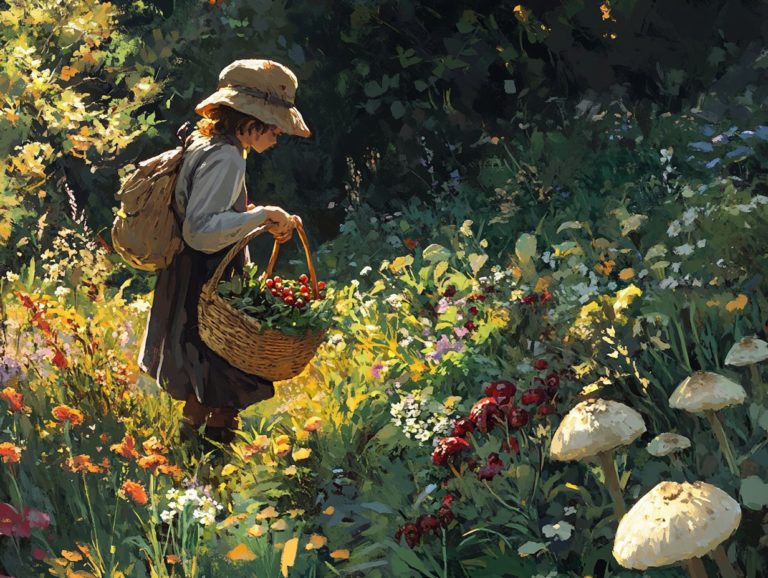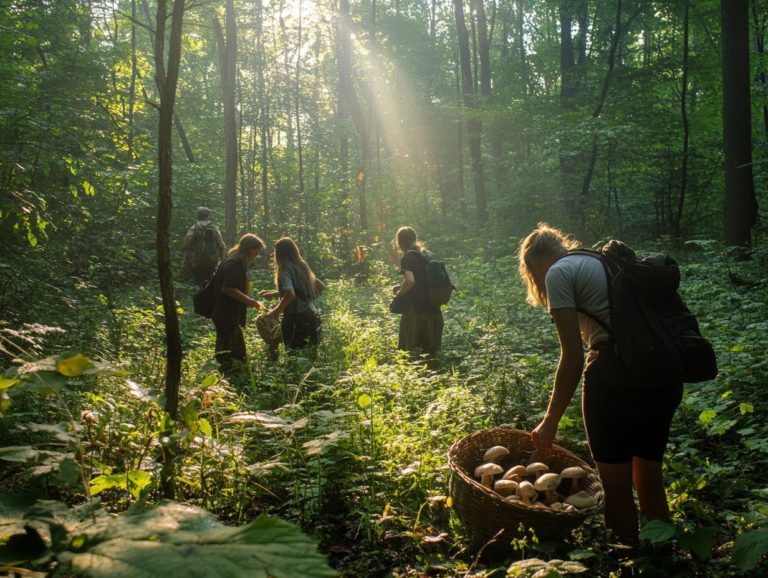Foraging Techniques: A Cultural Perspective
Foraging has intricately woven itself into the story of human existence. It has transformed from ancient survival practices into a vibrant aspect of contemporary culture, deeply rooted in the foraging lifestyle of early humans.
This exploration delves into the rich history of foraging. It traces its origins in early human societies, particularly within hunter-gatherer cultures, and examines the profound impact of agriculture. You ll uncover the cultural significance of foraging among Indigenous peoples. Witness its exciting resurgence in modern life.
From traditional techniques to the quest for edible plants and medicinal herbs, discover how foraging beautifully connects you with nature and your ancestors. This connection enriches your understanding of the world around you, reminiscent of the practices of the Hadza people.
Contents
- Key Takeaways:
- The History and Evolution of Foraging
- Cultural Significance of Foraging
- Foraging Techniques and Tools
- How to Forage for Food
- Foraging for Medicinal Purposes
- Frequently Asked Questions
- What are foraging techniques?
- How do foraging techniques vary across cultures?
- What role does culture play in foraging techniques?
- How have foraging techniques changed over time?
- What impact do foraging techniques have on the environment?
- How can we learn more about foraging techniques from different cultures?
Key Takeaways:

- Foraging has a rich history and has evolved from early practices to modern methods, influenced by the rise of agriculture.
- Foraging holds cultural significance, playing a role in traditional Indigenous cultures such as the kwakwa ka wakw and the Calusa, and is still utilized in modern society.
- Understanding and using various foraging techniques and tools, both traditional and modern, can lead to finding edible plants, wild game, and medicinal plants for food and healing purposes.
The History and Evolution of Foraging
The history and evolution of foraging tell a fascinating story of survival strategies that early humans employed. This is particularly evident within hunter-gatherer societies that flourished through hunting and foraging, showcasing diverse food procurement methods.
From the Ice Age to modern times, exploring these practices reveals amazing adaptability. It emphasizes how essential foraging lifestyles have been in shaping human evolution and cultural development, highlighting the insights found in foraging and sustainability: seasonal perspectives.
Noteworthy research from anthropologists like Richard B. Lee and Marshall Sahlins delves into the intricacies of hunter-gatherer culture. They shed light on groups such as the Hadza in Tanzania, the Nukak in Colombia, and diverse foraging practices across North Africa and the Amazon rainforest in Venezuela and Paraguay.
Early Foraging Practices
Early foraging practices among hunter-gatherer societies reveal a variety of strategies for food procurement. These include hunting for game, foraging for wild plants, and fishing for marine life.
In these communities, communal hunts were the norm. Groups worked together as a team, employing tracking techniques to ambush larger animals. This collaboration significantly boosted their chances of a successful kill.
Teamwork played a pivotal role, with hunters taking on specific roles that highlighted their individual strengths. This ensured a well-coordinated approach to tracking and capturing prey.
Foraging for edible plants also required a collective effort. Individuals would share valuable knowledge about seasonal availability and the best harvesting methods. This collaboration not only enhanced food security but also nurtured a profound connection to their environment, allowing these societies to adapt and thrive across diverse landscapes.
This synergy among hunter-gatherer cultures sustained their way of life across generations. Join the journey of rediscovery and connect with nature today!
Impact of Agriculture on Foraging
The advent of agriculture represents an important change for foraging lifestyles. Communities transitioned from hunting and gathering to more settled ways of getting food centered around cultivated crops.
This significant shift also brought various innovations in food production. It fundamentally altered not only diets but also the nature of social interactions. While foraging typically nurtured a culture of sharing and communal reliance on nature’s bounty, the rise of agricultural practices began to foster individual ownership of land and resources.
As a result, the dynamics of food sharing transformed. Surplus yields paved the way for social hierarchies to take shape.
As societies settled, they became increasingly structured. This led to clearer distinctions between roles within the community. Some individuals specialized in farming, while others pursued trades like tool-making or weaving.
This evolution in communal living profoundly influenced social organization and dietary patterns. It highlights the intricate relationship between food production and societal development.
Cultural Significance of Foraging
Foraging holds a vital place in many indigenous cultures, including the Hadza. It forms the bedrock of their social structures, spiritual beliefs, and sustainable practices.
Groups such as the Hadza, kwakwa ka wakw, Calusa, and Nukak exemplify how these practices are intricately woven into their way of life. They enrich their identity and connection to the land.
Foraging in Indigenous Cultures

Foraging communities, such as the Hadza and kwakwa ka wakw, beautifully illustrate the intricate bond between culture and the environment. They showcase distinctive practices in hunting, gathering, and resource management.
These communities embody a remarkable understanding of their ecosystems. Picture the Hadza expertly wielding traditional bow and arrow techniques to hunt game like antelope and zebra. Meanwhile, the kwakwa ka wakw skillfully navigate canoes for efficient hunts of sea otters and salmon.
In both cultures, communal hunts are essential. They promote collaboration and foster a strong sense of belonging. Sharing food transcends mere sustenance; it serves as a crucial social practice that strengthens bonds among community members. This ensures resources are equitably distributed and relationships among families are lovingly nurtured.
Foraging in Modern Society
Right now, foraging is trending as people reconnect with nature! Many are exploring local food resources through urban foraging practices, which means finding edible plants in cities.
This movement embodies a quest for sustainability and a broader variety of practices. It also strengthens community bonds as people gather in parks and gardens to uncover edible plants and mushrooms.
Urban foragers often employ techniques such as:
- Scavenging city parks
- Studying wild edibles through workshops
- Participating in community foraging events
You might find yourself on the hunt for dandelions, wild garlic, or even edible flowers thriving in those overlooked green spaces. This trend encourages healthier eating habits, reduces the carbon footprint linked to food transportation, and fosters a sense of stewardship for local ecosystems. It reflects the values of hunter-gatherer societies.
Join the movement today and discover the thrill of finding your own food!
Foraging Techniques and Tools
Foraging techniques have advanced significantly over time, showcasing the interplay of nature and foraging techniques. They blend a rich tapestry of tools and methods, including traditional hunting tools like the bow and arrow.
You can trace the evolution from the traditional bow and arrow, once essential for hunting animals, to contemporary strategies that emphasize tracking and collaboration in food procurement.
Traditional and Modern Methods
Traditional foraging methods, steeped in profound ecological knowledge, have seamlessly merged with modern practices, creating a variety of ways to find food that adapt beautifully to various environments, highlighting the role of foraging techniques in nutrition.
This synergy showcases a fascinating evolution in the way people gather sustenance, bridging the ancient wisdom of generations past with contemporary understanding. While traditional methods often leaned heavily on skills passed down through families and an intimate knowledge of local flora and fauna, current practices embrace technology and scientific insights to enhance sustainability.
By respecting seasons and the variety of life, you can carry forward the foundational principles of your ancestors while tackling today s pressing food security challenges. This blend enriches your foraging experience and builds a deeper appreciation for ecological balance and the importance of sustainable sourcing, as exemplified by early human societies. It highlights that foraging is not merely a trend; it is an essential necessity in our ever-evolving world.
How to Forage for Food
Foraging for food involves a rich tapestry of practices, from discovering edible plants to hunting wild game, highlighting the wide-ranging diet that defines numerous hunter-gatherer societies. Understanding the role of foraging techniques in sustainability can enhance our appreciation of their diverse food resources.
Edible Plants and Wild Game

Imagine the thrill of discovering edible plants and hunting wild game. These are essential skills for you as a forager, providing crucial food sources that sustain both traditional and modern foraging societies, echoing the wisdom of hunter-gatherer culture.
Take wild mushrooms, for example chanterelles and morels are not just culinary treasures; they re also packed with vitamins and minerals, making them an excellent addition to your diet and contributing to a broad spectrum diet. Foraging for dandelion greens can introduce valuable vitamins A, C, and K into your meals, highlighting the importance of seasonal plants in local ecosystems.
On the hunting front, small game like rabbits and squirrels not only serve as a protein-rich food source but also embody the traditions and survival skills of various cultures. They often grace community gatherings and feasts, illustrating the communal hunts of hunter-gatherer societies.
Together, these practices cultivate a profound connection to the land and enhance your self-sufficiency, echoing the timeless wisdom of living in harmony with nature, as seen in the practices of the Hadza people.
Foraging for Medicinal Purposes
Foraging for medicinal purposes is not just a practice; it s a revered tradition woven into the fabric of many cultures. You tap into a wealth of knowledge about medicinal plants and their transformative applications in health and wellness, bridging the gap between nature and healing.
Traditional Healing Practices
Traditional healing practices among indigenous cultures often have you foraging for specific medicinal plants believed to possess healing properties passed down through generations.
These methods show how much these communities respect nature. They also understand local ecosystems deeply. For instance, practitioners employ unique harvesting techniques that ensure the sustainability of the plants while honoring their medicinal lineage. This beautiful intertwining of ecological awareness and cultural heritage fosters a way of looking at health that considers the whole person, not just symptoms.
By utilizing native species such as echinacea or St. John s wort, you tap into the pharmacological potential of these plants while reinforcing the significance of stewardship and respect for the natural world.
Modern Applications
Modern applications of foraging for medicinal purposes are gaining well-deserved recognition as you seek out wild medicinal plants for their potential benefits as herbal remedies. This trend highlights the value of natural healing practices. Many are exploring their local environments for plants that have supported health for centuries.
Contemporary enthusiasts like you appreciate the therapeutic potential of these plants and embrace foraging as a means to reconnect with nature. In urban settings, workshops and community events are now emerging, enabling individuals to identify, harvest, and utilize these botanicals effectively. This exciting revival connects ancient wisdom with modern wellness practices and plays a significant role in the broader holistic health movement, which considers the whole person, including physical, emotional, and spiritual well-being.
Frequently Asked Questions
-
What are foraging techniques?
Foraging techniques are strategies and methods used by different cultures to obtain food and resources from their environment, reflecting the evolution of foraging techniques over time.
-
How do foraging techniques vary across cultures?
-
Foraging techniques can vary greatly depending on environmental factors, cultural norms, and available resources. To understand these variations, exploring the history of foraging techniques reveals how different cultures have developed unique methods to acquire food, such as hunting, fishing, gathering, and farming.
-
What role does culture play in foraging techniques?
-
Culture plays a significant role in foraging techniques as it influences the types of food that are considered acceptable, the methods used to obtain food, and the cultural practices surrounding foraging within a community.
-
How have foraging techniques changed over time?
-
Foraging techniques have evolved over time as cultures have adapted to changes in their environment and available resources. Understanding the connection between culture and foraging techniques reveals how the introduction of new technologies and cultural practices has also influenced the way people forage for food.
-
What impact do foraging techniques have on the environment?
-
Foraging techniques can have both positive and negative impacts on the environment. Sustainable foraging practices can help maintain a balance between human needs and the natural environment, while unsustainable practices can lead to depletion of resources and harm to ecosystems.
-
How can we learn more about foraging techniques from different cultures?
-
We can learn more about foraging techniques from different cultures through studying anthropological research, participating in cultural exchange programs, and engaging with indigenous communities. For a deeper insight, understanding regional foraging techniques is essential. It is important to approach this topic with respect and cultural sensitivity.
Join a local workshop today to start your foraging journey!







